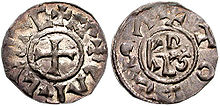£sd
![]()
This article or subsequent section is not sufficiently supported by evidence (e.g., anecdotal evidence). Information without sufficient evidence may be removed in the near future. Please help Wikipedia by researching the information and adding good supporting evidence.
The Carolingian coinage system (also called the Carolingian coinage order) was the late 8th-century establishment by Emperor Charlemagne for the minting of coins. Charlemagne's coinage order influenced coinage in Europe for several centuries. The coinage reform carried out by Charlemagne around 793/794 was of decisive importance for the medieval monetary system in Germany. Because gold could almost only be obtained through long-distance trade and there were sufficient silver deposits in Europe north of the Alps, he introduced a pure silver currency. The basic coin weight became the pound, from which 240 pennies were struck. The Carolingian pound weighed about 406½ grams.
The penny was the most important coin of the Middle Ages. The pound was a unit of weight and with this system it also became a unit of currency. Like the shilling, the pound was not minted for a long time, but was merely used as a coin of account. One shilling was worth exactly twelve pennies.
This system exists in several languages:
* Plural of denarius (denarius)
In Great Britain, this system persisted until the decimalization of 1971. It was also called the "£sd system" after the Latin abbreviations (libra, solidus, denarius). To this day, the Carolingian coinage system is officially the basis of the currency of the Order of Malta. However, since the Order no longer has its own national territory, the currency no longer has any real significance today.
The pound as a silver weight was supplanted by the mark from the 11th century onwards.

Carolingian denarius (denier)
See also
- Karlspfund
- Coins of the Middle Ages
- Saxon penny / coin foot
Search within the encyclopedia